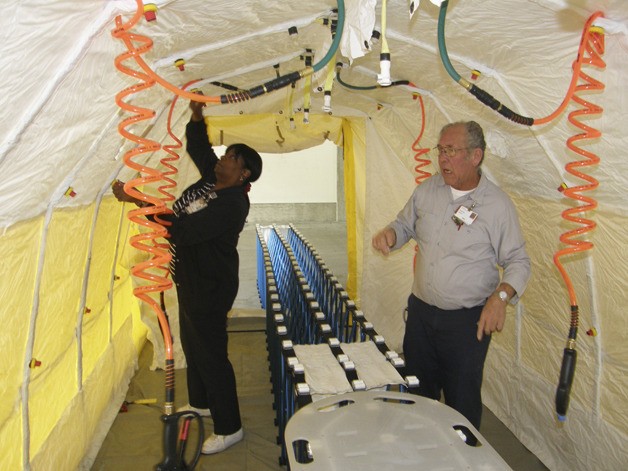Twenty-four hours ago, a massive earthquake rocked the Puget Sound region, cutting water to the University of Washington Hospital.
Now the time has come for the UW to evacuate its patients to all the other hospitals in the region — including Auburn Regional Medical Center (ARMC).
That scenario set the table for ARMC’s emergency drill Tuesday morning, part of a larger exercise designed and coordinated by the King County Healthcare Coalition and Public Health, Seattle & King County to see how well health care organizations throughout the region can move patients around if the struck hospital couldn’t care for them when disaster strikes.
“We will receive on-paper patients and perhaps some actual volunteer patients,” Matt Counas, facilities director for ARMC, said as the drill got under way shortly after 10 a.m.
Counas added that the drill not only tested ARMC’s ability to receive a load of patients but to check damage to its building and make hazard decontamination equipment and staff available to treat patients exposed to harmful chemicals.
That decontamination bit was specific to ARMC, with the hospital using the lower level of the ACE garage at 1st and South Division for its staging area.
“One of the things that we decided to do at the hospital level — which is really not part of the regional drill — is to set up our decontamination equipment,” Counas said. “That’s so that if we have walk-in patients who somehow were contaminated, and hazmat did not get to them first, we are set up to do decontamination. We’re not only going to set up portable showers, we’re also going to don the protective personal equipment and practice decontaminating patients.”
Vikki Lewis, environmental services director for ARMC, demonstrated the decontamination tent.
“We’re prepared to accept non-ambulatory patients, and we have a decontamination tent set up here,” Lewis said. “Let’s say the scenario was 30 degrees. We will be able to decontaminate our victims when they come through and provide hot water so they are not freezing. They will enter from the warm zone of the tent, and at the far end will be the cold zone. Eighty percent of the contamination is on the clothes, so we will remove their clothes. We will spray them down ensuring that we have removed all the contaminant, and they will progress to the end where they will be dried off and prepared for triage.”
The exercise, which ended at 2 p.m., involved all county hospitals, other health care organizations and emergency medical service providers. Harborview Medical Center, which serves as the primary hospital for directing patient distribution during a disaster, also played a role. The hospital continued to see patients during the drill.
Volunteers from the Public Health Reserve Corps and students from the University of Washington played patients during this exercise. They were transported to area hospitals as “evacuated patients” to help make the drill more realistic at receiving facilities. Approximately 30 volunteers will participate in the exercise.


